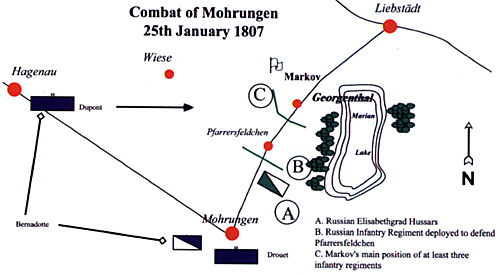Eylau: A Russian View
Battle of Mohrungen
by Patrick E. Wilson, UK
| |
Meanwhile, Markov had found himself under attack from the direction of the village of Wiese also, to counter this threat to his right flank he deployed two of his remaining regiments of infantry, who were able to show such a bold front that they were able to hold the enemy in that direction. Bernadotte had ordered this attack, led by General Dupont, earlier in the day and this attack combined with the advance by the Bernadotte from Pfarrersfeldchen convinced Markov that he ought to retire before he was overwhelmed. He was aided in this by the arrival of General Anrepp with more Russian cavalry, sadly whilst reconnoitring with Markov and his staff, Anrepp was killed by French skirmishers. However, Markov was able to make good his escape with the aid of Anrepp’s cavalry. At this point a strange thing happened, not only did Bernadotte’s pursuit slacken but it stopped altogether and it appeared that the French were actually turning about and returning to Mohrungen! The reason for this inexplicable event lay with a certain Colonel Dolgorucky, who at the head of three squadrons of the Courland Dragoons, had attacked Mohrungen and caused such havoc amongst Bernadotte’s supply trains that Bernadotte had to abandon his pursuit of Markov to stabilise the situation at Mohrungen. Dolgorucky, besides taking 300 French prisoners, released 200 Russian and Prussian captives and took 12,500 ducats and a quantity of silver from Bernadotte’s personal baggage. Losses in the combat of Mohrungen were heavy, given by Petre as 2,000 men on each side,
[2] and although the Bernadotte had snatched a minor victory, he was compelled to retreat on Liebemuhl the following day as the main Russian Army under Benningsen advanced upon Mohrungen.
Benningsen reached Mohrungen on 26th January, his army arriving there during that evening and on the 27th January, it had been marching for almost 16 days without rest and was exhausted. Deciding to rest his troops and replenish his stores, Benningsen appointed Prince Peter Bagration to command his advance guard units under Generals Markov, Bagavout and Barclay de Tolly and had him push forward to Saalfeld on the right and Guttstadt on the left.
Communications with the Prussian Corps under General Anton L’Estocq were to be opened by way of Deutsche-Eylau. However, Benningsen’s Army was not to be left to enjoy a period of rest and replenishment. The French army was on the move and its aim was to cut Benningsen off from his supply base at Königsberg and
drive him into the Frisches Haff, a phenomenal piece of luck saved Benningsen’s Army.
On the 1st February one of Bagration’s Cossack patrols captured a French courier who not only carried a set of orders for Bernadotte but also failed to destroy them. That set of orders contained an outline of Napoleon’s whole plan of campaign. Bagration of course read them before acting on the information and passing the despatch onto Benningsen. Benningsen could hardly believe what he was reading but ordered his Army to concentrate on Jonkowo to allow his outposts time to come in, especially the Prussian Corps under L’Estocq, who had been on their way to Thorn and Danzig. The move was a risky one as Jonkowo lay within the path of the advancing French but the position was a strong one. Northwest of Allenstein, formed by a range of hills and having in front of it a belt of water meadows, about one and half miles wide and intersected by ditches. The belt was formerly a lake bed and thus normally difficult to cross.
Unfortunately at this time of year it was frozen solid and the French were under no sort of obligation to attack it head on as it could be turned by crossing the River Alle at Bergfried. This was precisely what they intended to do, though it seems that Benningsen had anticipated such a move for he had placed General count Kamenskoi with his 14th Division and three Prussian heavy artillery batteries under Major Huguenin there whilst deploying the rest of his Army at Jonkowo.
Eylau: A Russian View by Patrick E. Wilson, UK
|
 Learning from prisoners taken at Liebstadt that the Bernadotte was marching on Mohrungen, General Markov pushed his troops towards that town. Encountering elements of Bernadotte's command, Markov took up a position to the north of Mohrungen at Georgenthal with his main body of troops and pushed forward a regiment of infantry and the Elisabethgrad Hussars to occupy the Village of Pfarrersfeldchen. Scarcely had Markov taken up these positions then the Prince of Ponte-Corvo attacked, his cavalry driving the Elisabethgrad Hussars back upon Georgenthal. However Markov’s infantry at Pfarrersfeldchen put up a more sustained defence, beating off the first attack of the Prince of Ponte-Corvo's infantry and taking a standard of the 27th Legere. A second attack though drove Markov’s infantry back
upon Georgenthal, this attack was made with at least four battalions supported by General Laplanche’s Dragoons. Bernadotte quickly followed up his success by
advancing con Georgenthal itself.
Learning from prisoners taken at Liebstadt that the Bernadotte was marching on Mohrungen, General Markov pushed his troops towards that town. Encountering elements of Bernadotte's command, Markov took up a position to the north of Mohrungen at Georgenthal with his main body of troops and pushed forward a regiment of infantry and the Elisabethgrad Hussars to occupy the Village of Pfarrersfeldchen. Scarcely had Markov taken up these positions then the Prince of Ponte-Corvo attacked, his cavalry driving the Elisabethgrad Hussars back upon Georgenthal. However Markov’s infantry at Pfarrersfeldchen put up a more sustained defence, beating off the first attack of the Prince of Ponte-Corvo's infantry and taking a standard of the 27th Legere. A second attack though drove Markov’s infantry back
upon Georgenthal, this attack was made with at least four battalions supported by General Laplanche’s Dragoons. Bernadotte quickly followed up his success by
advancing con Georgenthal itself.